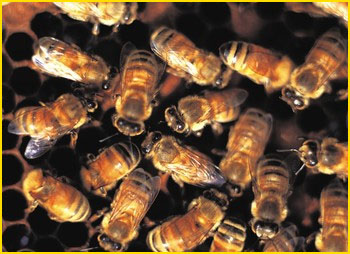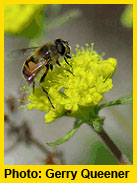Pollinator Overview
 (For links with comprehensive information about pollinators, CLICK HERE.
(For links with comprehensive information about pollinators, CLICK HERE.
Many people think only of allergies when they hear the word pollen. But pollination — the transfer of pollen grains to fertilize the seed-producing ovaries of flowers — is an essential part of a healthy ecosystem. Pollinators play a significant role in the production of over 150 food crops in the United States — among them apples, alfalfa, almonds, blueberries, cranberries, kiwis, melons, pears, plums, and squash.
Bees, both managed honey bees and native bees, are the primary pollinators. In the United States, the annual benefit of managed honey bees to consumers is estimated at $14.6 billion. The services provided by native pollinators further contribute to the productivity of crops as well as to the survival and reproduction of many native plants.
However, more than 100,000 invertebrate species, including bees, moths, butterflies, beetles, flies, hummingbirds, ants, and wasps serve as pollinators — as well as 1,035 species of vertebrates, including birds, mammals, and reptiles.
Bats play a key role in many ecosystems. They pollinate the fragrant, white or pale flowers that bloom and night and disperse the seeds of more than 300 plant species. Can you imagine life without cashews, mangos, carob, dates, figs, papaya, guava and cloves? These are a few of the many plants which depend on bats for their survival.
Bats, hummingbirds, ants, beetles, wasps, butterflies, moths, flies and even lizards are "busy as bees" each spring and summer pollinating flowers.
 Did you know that some of the world’s top pollinators are flies? Long-tongue flies, gnats, and yes, even male mosquitoes! Some male mosquitoes help to pollinate rare orchids; the pollen grains actually stick to their eyes as they travel from flower to flower. When they dip their proboscis (mouth tube) into the flower to take a sip of nectar, the pollen grains mix and pollination takes place.
Did you know that some of the world’s top pollinators are flies? Long-tongue flies, gnats, and yes, even male mosquitoes! Some male mosquitoes help to pollinate rare orchids; the pollen grains actually stick to their eyes as they travel from flower to flower. When they dip their proboscis (mouth tube) into the flower to take a sip of nectar, the pollen grains mix and pollination takes place.
A lot of pollinating flies, like hover flies and bee flies, disguise themselves as bees or wasps. Flies use this mimicry to protect themselves against predators. If an insect looks like it might sting, a predator might not try to eat it. How can you tell the difference between a honeybee and a bee fly? Check out the wings. If the insect has one pair of wings, it’s a fly. Two pairs? A bee.
Despite the valuable services that pollinators provide, long-term population trends for some North American pollinators are "demonstrably downward," says a new report from the National Research Council1.
Observable decreases in wild populations of bees, butterflies, and moths are of great concern to producers of fruits, vegetables, nuts, alfalfa, and flowers. These crops depend on wild and domestic pollinators. Growers in California, Florida, Arizona, Utah, Washington, and Hawaii are especially concerned. More important is the disturbing notion of an imbalance in the natural ecosystem and biodiversity on which all food production depends. Habitat loss for pollinators by human activity poses an immediate and frequently irreversible threat. Other factors responsible for population decreases include invasive plant species, broad-spectrum pesticide use, disease, and weather.
For the most part, the general public is unaware of the decrease in pollinator populations and the implications this has for agricultural production.
1 "Status of Pollinators in North America, " Committee on the Status of Pollinators in North America, National Research Council
View report.